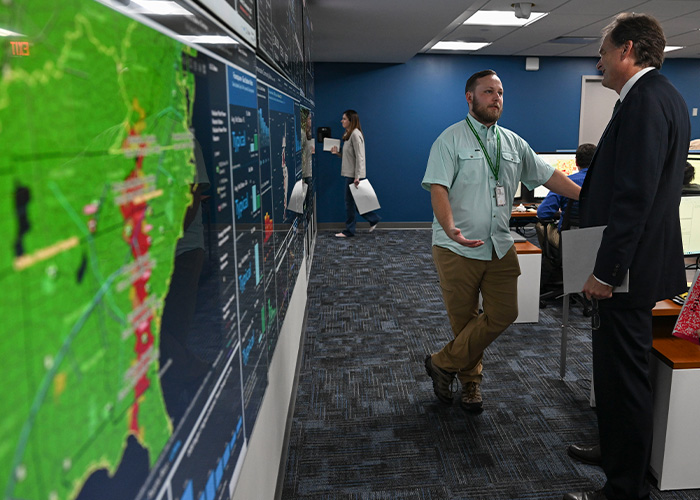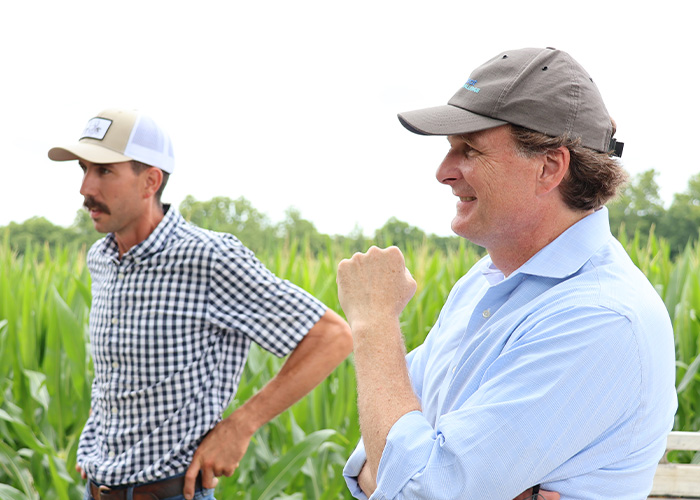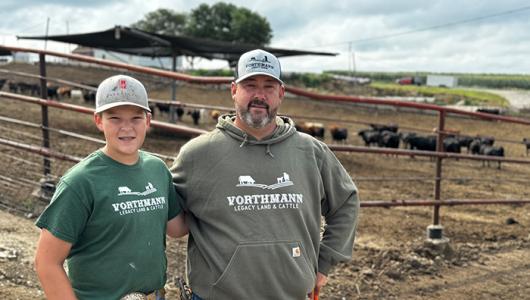As I look back over the past year, I am filled with pride for what we have accomplished together. Through collaboration, innovation, and a shared commitment, we are shaping a more sustainable future for all farmers, ranchers, and landowners.
Still our work is far from over. While the road ahead may hold uncertainties, one thing remains clear: USDA will continue standing alongside our producers. We remain steadfast in our mission to support you and provide the resources and assistance needed to work through challenges and take advantage of future. Together we can keep building on this foundation of progress.
Last year was full of opportunities for us to engage with agricultural producers and forest landowners, seeking feedback on how our programs can help, not hinder, the work they do, and allow us to provide flexibilities where we are able. Here are a few key areas where we made a difference together this year.

Disaster Recovery
2024 was not spared from natural disaster wreaking havoc on our nation’s agricultural producers. From drought, to wildfire, to back-to-back devasting hurricanes, our team stood ready to provide needed assistance to endure and recover and adapt flexible programs to best meet producers’ needs.
One key step was providing flexibility for producers impacted by hurricanes Debby, Helene, and Milton to begin certain restoration activities through the Emergency Conservation Program and Emergency Forest Restoration Program prior to Farm Service Agency (FSA) approval or on-site inspection. By reducing required documentation and simplifying environmental compliance reviews, producers could implement restoration activities sooner and our offices could quickly approve cost share payments.
We responded quickly by providing producers with Federal crop insurance coverage through the Hurricane Insurance Protection – Wind Index (HIP-WI) endorsement and the Tropical Storm (TS) option indemnity payments within a few weeks of the storms making landfall. Covered producers received over $770 million in indemnities for hurricane-related losses this year.
In response to the Highly Pathogenic Avian Influenza (H5N1) in dairy herds, we expanded our Emergency Assistance for Livestock, Honeybees and Farm-raised Fish Program to assist with a portion of financial losses resulting from reduced milk production when cattle are removed from commercial milking in dairy herds having a confirmed positive H5N1 test.
Farm Loan Improvements
In September, we made changes to FSA’s farm loan programs as part of the Enhancing Program Access and Delivery for Farm Loans rule. These changes were designed to better assist borrowers to make strategic investments in the enhancement or expansion of their agricultural operations. Most notably, the rule establishes a new low-interest installment set-aside program for financially distressed borrowers; provides all eligible loan applicants access to flexible repayment terms; and reduces additional loan security requirements to enable borrowers to leverage equity.
FSA continues to look for ways to streamline and automate the Farm Loan Program customer-facing business process including an online direct loan repayment feature and a Debt Consolidation Tool.
We continued to support distressed direct and guaranteed farm loan borrowers under Section 22006 of the Inflation Reduction Act by providing assistance to distressed direct and guaranteed farm loan borrowers. In total, USDA has provided approximately $2.5 billion in assistance to more than 47,700 financially distressed farmers and ranchers, thanks to resources provided through the Inflation Reduction Act.

Conservation & Climate
Producer demand for conservation assistance remains strong, and we continued to meet that demand in 2024.
USDA supported more than 23,000 climate-focused conservation contracts funded by the Inflation Reduction Act. These investments cover over 11 million acres in fiscal year 2024, contributing to the highest total investment in private lands conservation in any year in the history of the Natural Resources Conservation Service (NRCS). Up to $7.7 billion in assistance will be made available for fiscal year 2025. NRCS also announced details for improving greenhouse gas estimates through investing $300 million in GHG Measurement, Monitoring, Reporting and Verification (MMRV), provided by the Inflation Reduction Act.
In October, we also announced a historic $1.5 billion for 92 partner-driven conservation projects through the Regional Conservation Partnership Program (RCPP) to help farmers, ranchers, and forest landowners adopt and expand voluntary, locally led conservation strategies to enhance natural resources while tackling the climate crisis.
FSA accepted offers for more than 2.2 million acres from agricultural producers and private landowners through this year’s Grassland, General, and Continuous Conservation Reserve Program signups.
We’re deploying our voluntary conservation programs to improve terrestrial wildlife habitat connectivity and corridors on working landscapes through the management of National Forests and voluntary conservation assistance on private agricultural lands. In fall 2024, Agricultural Secretary Tom Vilsack announced a Department-wide effort to support habitat connectivity, bringing together our programs with those from other parts of USDA. We also launched the Northern Bobwhite Pilot Project, providing dedicated funding of $13 million – for fiscal year 2024 – in new assistance through NRCS’ Environmental Quality Incentives Program in 18 states. This is for producers to help the bobwhite and other game and non-game species by managing their working lands for early successional habitat while meeting their lands natural resource and production goals.
To help support our work and train the next generation of conservation and climate leaders, we selected 28 organizations to host members of USDA Working Lands Climate Corps who will provide technical training and career pathway opportunities for young people, helping them deliver economic benefits through climate-smart agriculture solutions for farmers and ranchers across the country, now and in the future.
Managing Risk
The Risk Management Agency continues to explore ways to adjust and create new policies based on producer needs and feedback. Just a few examples of these improvements made in 2024 include:
- Announcing an increase in replant payments for most producers beginning with the 2026 crop year. Replant payment factors have not been updated since they were established in the 1990s and were reviewed to ensure they reflect current replanting costs.
- Expanded revenue protection to flax producers, coverage of shellfish and grapevines, and the Enhanced Coverage Option (ECO) to include additional crops as well as increasing premium support for all crops covered by ECO.
- Offering coverage of the Nursery Value Select program to all counties in all states and expanding the Pasture, Rangeland and Forage Crop Insurance to Hawaii.
- Expanding crop insurance options for specialty and organic growers by allowing enterprise units by organic farming practice and adding enterprise unit eligibility for several crops.
We also invested $4.1 million to organizations and outreach efforts to educate underserved, small-scale, and organic producers on farm risk management and climate-smart farm practices through RMA’s Risk Management Education Partnerships.
Commodity Support
Through Partnerships for Climate-Smart Commodities, USDA is expanding markets for commodities produced using climate-smart production methods. This effort is helping farmers, ranchers, and private forest landowners implement climate-smart production practices on working lands to build soil health, reduce greenhouse gas emissions, sequester carbon, enhance productivity and build revenue. USDA released a progress report highlighting the successes of Partnerships for Climate-Smart Commodities in January 2025. Since its creation in September 2022, USDA has invested $3.03 billion in 135 projects, enrolling more than 21,000 farms encompassing over 5.2 million acres of working land into climate-smart practices. The resulting climate-smart commodities are starting to hit the shelves, including beef, coffee, almonds, rice, dairy products and 49 other products.
This year we also announced the investment of $400 million through the Water Savings Commodity Program to support irrigation districts and producers in using innovative water savings technologies and farming practices while producing water-saving commodities in the face of continued drought. This funding is expected to conserve up to 50,000 acre-feet in water use across 250,000 acres of irrigated land in production, while expanding and creating new, sustainable market opportunities.
Advancing Equity and Serving All Producers
This summer, we announced $50 million to 141 awardees help improve the resiliency of the U.S. food supply chain by addressing agriculture labor challenges and instability, strengthen protections for farmworkers, and expand legal pathways for labor migration through the Farm Labor Stabilization and Protection Pilot Program.
NRCS released a new Tribal Relations Strategy, demonstrating the agency’s commitment to honoring its federal trust relationship with the 574 federally recognized tribes and Alaska Native Villages that have sovereign interest in more than 119 million acres of land across the United States.
Support for Specialty Crop, Urban and Innovative Producers
We invested $5.2 million in 17 new grants in 13 states that support urban agriculture and innovative production and approximately $11.5 million in 38 cooperative agreements that support innovative, scalable waste management plans to reduce and divert food waste from landfills.
FSA made improvements to its acreage reporting software, providing more flexibility for reporting acreage on a smaller scale and identifying innovative planting practices like multi-level planting or vertical farming practices.
Most recently, we announced the Marketing Assistance for Specialty Crops program, aimed at helping specialty crop producers expand markets and manage higher costs. USDA also expanded the Food Safety Certification for Specialty Crops program to include additional businesses and assistance on expenses through 2025.


